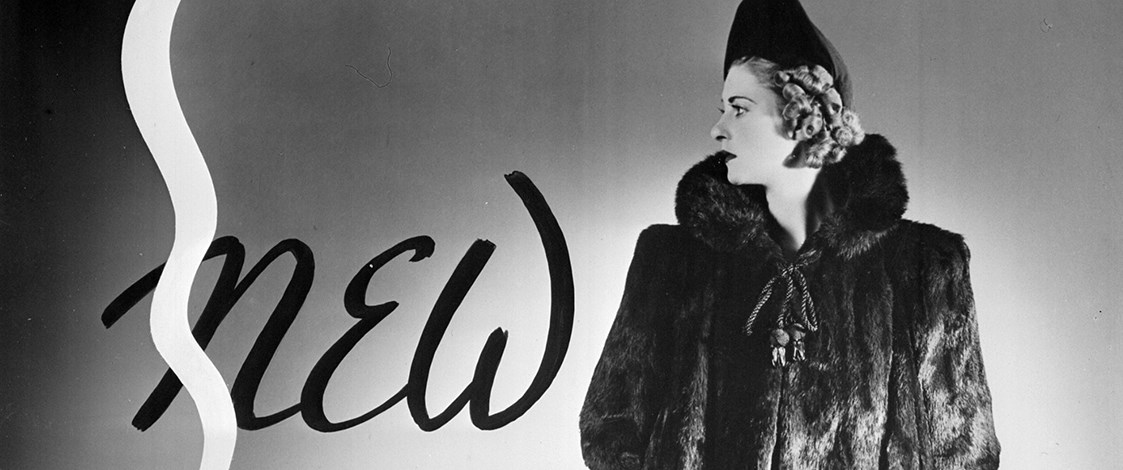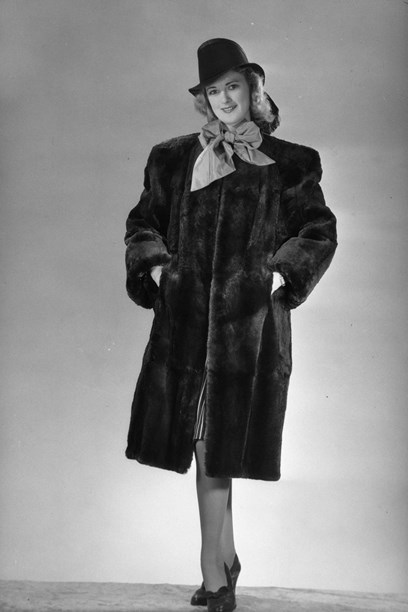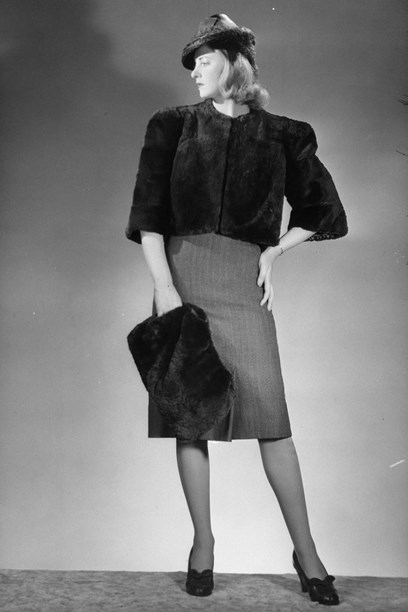Stories
Mooneys Furs
1912-

For much of the 20th century, fur was considered a glamour item, conferring upon the wearer both status and style. The upper classes wore fur. Fur was Hollywood’s idea of luxury. Inspired by what they saw in the social pages of magazines and in the movies, most women aspired to owning a fur coat.

Full-length fur coat by Mooneys Furs, circa 1940s. Photo by Clifton Firth, courtesy of Auckland Libraries Heritage Collections, 34-M53B.
In New Zealand, as in other countries, the fur trade thrived. Mooneys, famous for its fashion furs, was one of the country’s main wholesalers, selling into the major department stores and to smaller furriers who needed to supplement their stock. It also had its own showrooms which were open to the public.
Founded by George Stewart and James Kennedy Mooney, Mooneys started out in Dunedin in 1912 as J K Mooney and Company, trader and exporter of rabbit skins. In 1923, the firm diversified into making and selling fur garments, opening a second business, Mooneys Furs , specifically for this purpose. A third business, Fur Dressers and Dyers, was set up in 1927 to process local and imported skins. Following the stock-market crash in 1929, the latter was sold and Mooneys Furs was taken over by the Braham brothers, a family of professional furriers from London. Sidney Braham co-owned and ran Mooneys with his brothers Harry, Alf, and Phil Braham. Outside of this venture he also owned Selby, another fashion business, independently. Although J.K Mooney continued to operate independently as a rabbit skin trader, it had no further links with fashion.
Making a fur garment required specialist skills and, at its peak, Mooneys employed up to 20 trained craftspeople in each of its workrooms in Auckland, Wellington and Dunedin. "Even the patterns were highly specialised," explains Evan Tosh, a former manager of Fur Dressers and Dyers, processors of Mooneys’ skins. "Patterns for fur were completely different from patterns for fabric. No seam allowances, for one thing, and the pelts had to be matched and pieced together, unlike ordinary garments which were cut from one piece of cloth." Mooneys purchased the special patterns from catalogues of fur styles which were produced regularly by fur specialists in New York and London.

Fur coat photographed for Mooneys Furs in the 1940s by Clifton Firth. Photo courtesy of Auckland Libraries Heritage Collections, 34-M53G.
By referencing the international style catalogues, Mooneys was able to ensure that New Zealand women were kept up to date - fur being as subject to the whims of fashion as any other clothing. Trends tended to be interpreted in decades rather than seasons. Fur was expensive, and women didn’t change their fur coats as frequently as they did their other fashion items such as hats, bags gloves or shoes.

Full-length fur coat by Mooneys Furs, circa 1940s. Photo by Clifton Firth, Photo courtesy of Auckland Libraries Heritage Collections, 34-M53K.
Photographs taken by Auckland fashion photographer Clifton Firth for Mooneys in the 1940s, show models wearing full-length, edge-to-edge fur coats with wide sleeves and the broad shoulders popularised by Hollywood costume designers and Paris-based Italian couturiere Elsa Schiaparelli. A cropped fur jacket is shown with a matching fur muff, which would probably have had a pocket incorporated in the lining.

Edge-to-edge cropped fur jacket and matching muff, made in the 1940s by Mooneys Furs and photographed by Clifton Firth. Photo courtesy of Auckland Libraries Heritage Collections, 34-M53D.
American musquash, a dark brown fur shading to honey tones and silver, was hugely popular in New Zealand from the 1920s to the 1950s. The vogue for red or silver fox fur stoles, made with a full pelt complete with head and feet, and worn with tailored suits or dresses, was more short-lived. By the late 1940s and throughout the next two decades, stoles, shawl wraps and shorter coats with matching fur hats accounted for much of Mooneys’ output.
When Heather Kirk joined Mooneys as a cutter in Dunedin in the 1970s, the fur scene was changing. Young alternative dressers were seeking out vintage fur coats and fox fur stoles which they wore ironically with op shop clothing or jeans, while many traditional fur coat wearers wanted a more contemporary look. Heather recalls one woman being employed in the Dunedin workroom solely to repair or modernise old furs. "There wasn’t much call for new full-length coats," she says. "We made hats, wraps, stoles and lots of jackets." The furs of choice at this time were squirrel, farmed mink, Australian red fox, Russian marmot, possum and Belgian and French rabbit.

Mooney's label, 1950s.
Rabbit never had the same cachet as other furs but it was inexpensive and could be sheared or dyed to imitate pricier pelts with surprisingly good results. Possum, also inexpensive but thicker and plusher than rabbit, looked more luxurious.
A change of management in 1982 saw the closure of Mooneys’ Auckland and Wellington workrooms and the opening of a new smartly appointed shop in Dunedin. In 1998, this also closed. That same year, the business was bought by Heather Kirk and Max Wilson, a second generation furrier who had been brought over from England by Mooneys in the mid-1980s.
Protests over the use of fur in the 1980s and 1990s led to a drop in fur sales worldwide. By working mainly with possum and rabbit, non-endangered species posing a major threat to New Zealand’s natural environment, Mooneys weathered the storm. Of all the New Zealand furriers who flourished in the 'fur years', it is the sole survivor.
Entering its 94th year, Mooneys, now known as Mooneys Furriers, is a small scale Dunedin business producing possum fashion accessories and items for the home. Owners Max and Heather also specialise in the repair and restyling of vintage furs and make to order for individual clients and fashion designers such as Juliet Hogan, Harman Grubisa and Jane Avery to whom they passed on the tricks of the fur trade when she launched her Lapin (French for rabbit) clothing label in 2016. The ethical lifestyle fashion brand Snowy Peak is another major client.
Designed by Jane Avery in 2017 for her Lapin label, this pure wool coat is trimmed with wild rabbit.
Special projects include the creation of the full-length white fox fur cape (pieced together to represent drops of snow) worn by Tilda Swinton for her role as the White Witch in the 2005 movie The Chronicles of Narnia: The Lion, the Witch and the Wardrobe.
Text by Cecilie Geary. Banner image by Clifton Firth, courtesy of Auckland Libraries Heritage Collections, 34-M53Q.
Published February 2014.